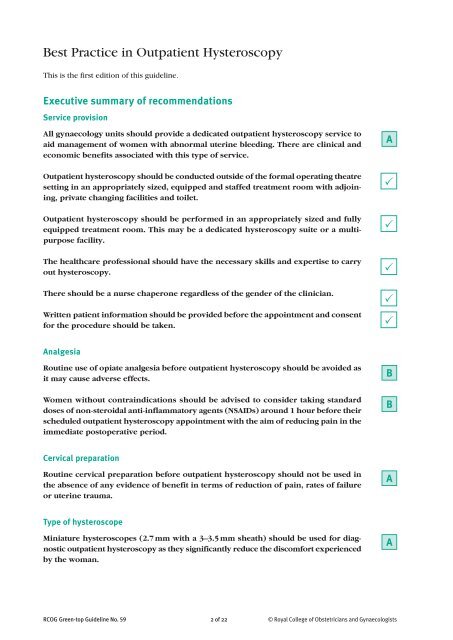Best Practice in Outpatient Hysteroscopy - British Society for ...
Best Practice in Outpatient Hysteroscopy - British Society for ...
Best Practice in Outpatient Hysteroscopy - British Society for ...
Create successful ePaper yourself
Turn your PDF publications into a flip-book with our unique Google optimized e-Paper software.
<strong>Best</strong> <strong>Practice</strong> <strong>in</strong> <strong>Outpatient</strong> <strong>Hysteroscopy</strong><br />
This is the first edition of this guidel<strong>in</strong>e.<br />
Executive summary of recommendations<br />
Service provision<br />
All gynaecology units should provide a dedicated outpatient hysteroscopy service to<br />
aid management of women with abnormal uter<strong>in</strong>e bleed<strong>in</strong>g. There are cl<strong>in</strong>ical and<br />
economic benefits associated with this type of service.<br />
<strong>Outpatient</strong> hysteroscopy should be conducted outside of the <strong>for</strong>mal operat<strong>in</strong>g theatre<br />
sett<strong>in</strong>g <strong>in</strong> an appropriately sized, equipped and staffed treatment room with adjo<strong>in</strong><strong>in</strong>g,<br />
private chang<strong>in</strong>g facilities and toilet.<br />
<strong>Outpatient</strong> hysteroscopy should be per<strong>for</strong>med <strong>in</strong> an appropriately sized and fully<br />
equipped treatment room. This may be a dedicated hysteroscopy suite or a multipurpose<br />
facility.<br />
The healthcare professional should have the necessary skills and expertise to carry<br />
out hysteroscopy.<br />
There should be a nurse chaperone regardless of the gender of the cl<strong>in</strong>ician.<br />
Written patient <strong>in</strong><strong>for</strong>mation should be provided be<strong>for</strong>e the appo<strong>in</strong>tment and consent<br />
<strong>for</strong> the procedure should be taken.<br />
Analgesia<br />
Rout<strong>in</strong>e use of opiate analgesia be<strong>for</strong>e outpatient hysteroscopy should be avoided as<br />
it may cause adverse effects.<br />
Women without contra<strong>in</strong>dications should be advised to consider tak<strong>in</strong>g standard<br />
doses of non-steroidal anti-<strong>in</strong>flammatory agents (NSAIDs) around 1 hour be<strong>for</strong>e their<br />
scheduled outpatient hysteroscopy appo<strong>in</strong>tment with the aim of reduc<strong>in</strong>g pa<strong>in</strong> <strong>in</strong> the<br />
immediate postoperative period.<br />
Cervical preparation<br />
Rout<strong>in</strong>e cervical preparation be<strong>for</strong>e outpatient hysteroscopy should not be used <strong>in</strong><br />
the absence of any evidence of benefit <strong>in</strong> terms of reduction of pa<strong>in</strong>, rates of failure<br />
or uter<strong>in</strong>e trauma.<br />
Type of hysteroscope<br />
M<strong>in</strong>iature hysteroscopes (2.7 mm with a 3–3.5 mm sheath) should be used <strong>for</strong> diagnostic<br />
outpatient hysteroscopy as they significantly reduce the discom<strong>for</strong>t experienced<br />
by the woman.<br />
RCOG Green-top Guidel<strong>in</strong>e No. 59 2 of 22 © Royal College of Obstetricians and Gynaecologists<br />
A<br />
<br />
<br />
<br />
<br />
<br />
B<br />
B<br />
A<br />
A



